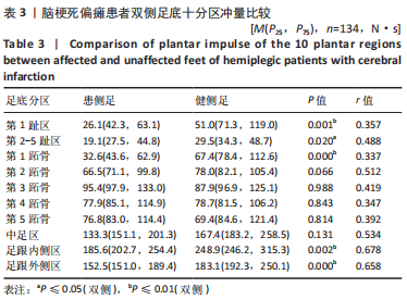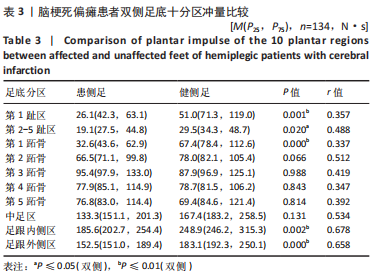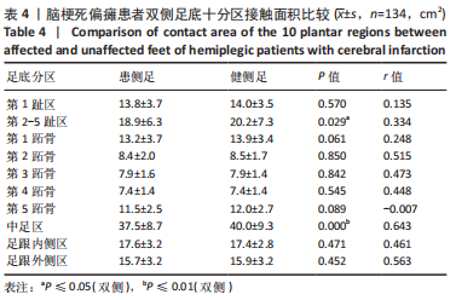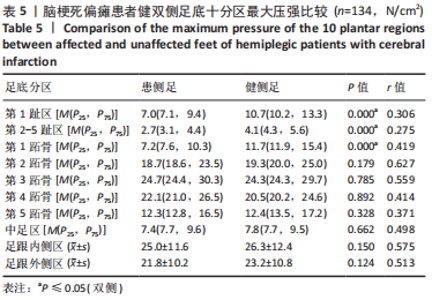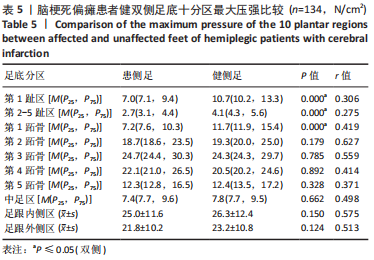Chinese Journal of Tissue Engineering Research ›› 2023, Vol. 27 ›› Issue (23): 3609-3615.doi: 10.12307/2023.563
Gait analysis for hemiplegic patients with cerebral infarction based on RSSCAN gait system
Jin Naying, Wu Jiabao, Li Yuyue, Li Yingjie, Zhou Li, Li Zongheng, Zhang Yong
- Department of Rehabilitation, Dongzhimen Hospital Affiliated to Beijing University of Chinese Medicine, Beijing 100700, China
-
Received:2022-08-24Accepted:2022-10-14Online:2023-08-18Published:2023-01-16 -
Contact:Zhang Yong, MD, Associate chief physician, Master’s supervisor, Department of Rehabilitation, Dongzhimen Hospital Affiliated to Beijing University of Chinese Medicine, Beijing 100700, China -
About author:Jin Naying, Master candidate, Department of Rehabilitation, Dongzhimen Hospital Affiliated to Beijing University of Chinese Medicine, Beijing 100700, China -
Supported by:the National Natural Science Foundation of China, Nos. 81673894 (to LZH) and 81804160 (to ZY)
CLC Number:
Cite this article
Jin Naying, Wu Jiabao, Li Yuyue, Li Yingjie, Zhou Li, Li Zongheng, Zhang Yong. Gait analysis for hemiplegic patients with cerebral infarction based on RSSCAN gait system[J]. Chinese Journal of Tissue Engineering Research, 2023, 27(23): 3609-3615.
share this article
Add to citation manager EndNote|Reference Manager|ProCite|BibTeX|RefWorks
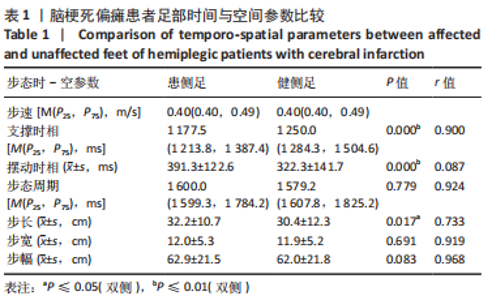
2.1 参与者数量分析 134例受试者均顺利完成测试过程,全部进入结果分析。 2.2 受试者足轴角测试结果 134例受试者健、患侧足足轴角分别为(15.8±8.6)°,(17.4±9.6)°,组间比较差异无显著性意义(P > 0.05),但两足足轴角具有显著正相关关系(r=0.280,P≤0.01)。 2.3 受试者足部时-空参数测试结果 受试者健侧足支撑时间大于患侧足(P < 0.01),摆动时间小于患侧足(P < 0.01),步长小于患侧足(P < 0.05);健、患侧足步宽、步幅、步态周期时间无明显差异(P > 0.05)。Pearson或Spearman秩相关性分析表明,健、患侧足支撑时间、步态周期、步长、步宽、步幅具有显著正相关关系(P < 0.01),见表1。"
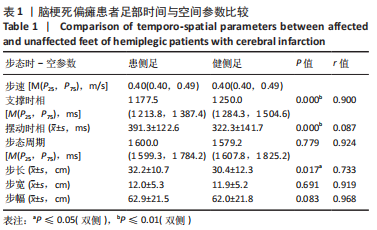
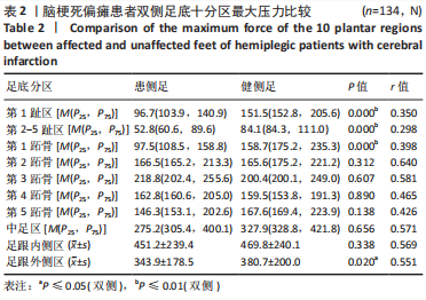
2.4 受试者足底生物力学相关参数 总体来说,与患侧足相比,健侧足在第1趾区、第2-5趾区、第1跖骨区的最大压力、最大压强、足部冲量增大(P < 0.05),足跟内侧区、足跟外侧区的足冲量增加(P < 0.01),足跟外侧区的最大压力增大(P < 0.05),第2-5趾区、中足区的足底接触面积增加(P < 0.05),见表2-5。 相关性分析表明,健侧足与患侧足在足底十分区的最大压力、最大压强和足冲量值均具有显著正相关关系(P < 0.01),健侧足与患侧足在第2-5趾区、第1跖骨区、第2跖骨区、第3跖骨区、第4跖骨区、中足区、足跟内侧区、足跟外侧区的足底接触面积具有显著正相关关系(P≤0.01),见表2-5。"
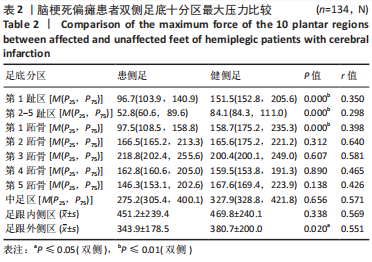
| [1] GBD 2019 DISEASES AND INJURIES COLLABORATORS. Global burden of 369 diseases and injuries in 204 countries and territories, 1990-2019: a systematic analysis for the Global Burden of Disease Study 2019. Lancet. 2020;396(10258):1204-1222. [2] 《中国脑卒中防治报告》编写组.我国脑卒中防治仍面临巨大挑战——《中国脑卒中防治报告2018》概要[J].中国循环杂志,2019, 34(2):105-119. [3] VAN DE PORT IG, WOOD-DAUPHINEE S, LINDEMAN E, et al. Effects of exercise training programs on walking competency after stroke: a systematic review. Am J Phys Med Rehabil. 2007;86(11):935-951. [4] YANG JK, AHN NE, KIM DH, et al. Plantar Pressure Distribution During Robotic-Assisted Gait in Post-stroke Hemiplegic Patients. Ann Rehabil Med. 2014;38(2):145-152. [5] BELGEN B, BENINATO M, SULLIVAN PE, et al. The association of balance capacity and falls self-efficacy with history of falling in community-dwelling people with chronic stroke. Arch Phys Med Rehabil. 2006; 87(4):554-561. [6] SUN H, ZOU X, LIU L. Epidemiological factors of stroke: a survey of the current status in china. J Stroke. 2013;15(2):109-114. [7] YEGANEH DOOST M, HERMAN B, DENIS A, et al. Bimanual motor skill learning and robotic assistance for chronic hemiparetic stroke: a randomized controlled trial. Neural Regen Res. 2021;16(8):1566-1573. [8] WANG C, KIM Y, SHIN H, et al. Preliminary Clinical Application of Textile Insole Sensor for Hemiparetic Gait Pattern Analysis. Sensors (Basel). 2019;19(18):3950. [9] ROGERS A, MORRISON SC, GORST T, et al. Repeatability of plantar pressure assessment during barefoot walking in people with stroke. J Foot Ankle Res. 2020;13(1):39. [10] XU C, WEN XX, HUANG LY, et al. Normal foot loading parameters and repeatability of the Footscan® platform system. J Foot Ankle Res. 2017;10: 30. [11] MOLINA-RUEDA F, CARRATALá-TEJADA M, CANO DE LA CUERDA R, et al. Examination of the reliability of Gait Assessment and Intervention Tool in patients with a stroke. Int J Rehabil Res. 2018;41(1): 84-86. [12] 龚晓芹,钟平,曹立.神经科疾病常用的步态评估方法[J].中华神经科杂志,2022,55(2):174-180. [13] KWAKKEL G, LANNIN NA, BORSCHMANN K, et al. Standardized measurement of sensorimotor recovery in stroke trials: Consensus-based core recommendations from the Stroke Recovery and Rehabilitation Roundtable. Int J Stroke. 2017;12(5):451-461. [14] 各类脑血管疾病诊断要点[J].中华神经科杂志,1996,29(6):60-61. [15] 中国中西医结合学会神经科专业委员会.中国脑梗死中西医结合诊治指南(2017)[J].中国中西医结合杂志,2018,38(2):136-144. [16] 罗炯.足底压力分布测量技术的应用特点[J].中国组织工程研究与临床康复,2007,11(9):1734-1737. [17] 黄萍,钟慧敏,陈博,等.正常青年人三维步态:时空及运动学和运动力学参数分析[J].中国组织工程研究,2015,19(24):3882-3888. [18] BEYAERT C, VASA R, FRYKBERG GE. Gait post-stroke: Pathophysiology and rehabilitation strategies. Neurophysiol Clin. 2015;45(4-5):335-355. [19] BATCHELOR FA, MACKINTOSH SF, SAID CM, et al. Falls after stroke. Int J Stroke. 2012;7(6):482-490. [20] FERRARELLO F, BIANCHI VA, BACCINI M, et al. Tools for observational gait analysis in patients with stroke: a systematic review. Phys Ther. 2013;93(12):1673-1685. [21] 杜琳,张章,韩义皇,等.足印分析法评价针灸治疗中风痉挛步态疗效[J].中国中医药信息杂志,2013,20(2):74-75. [22] 胡填,古剑雄.三维步态分析技术在脑卒中后偏瘫步态中的应用进展[J].实用心脑肺血管病杂志,2021,29(11):124-128. [23] LOW DC, DIXON SJ. Footscan pressure insoles: accuracy and reliability of force and pressure measurements in running. Gait Posture. 2010; 32(4):664-666. [24] 曹娟娟.脑卒中偏瘫足内翻患者的足底压力分布研究[D].合肥:安徽医科大学,2015. [25] 张高阳,张永刚,王伟伟.足底压力测试系统在运动员选材与训练中的应用[J].当代体育科技,2022,12(5):35-39. [26] 单莎瑞,黄国志,曾庆,等.步态诱发功能性电刺激对脑卒中后足下垂患者步态时空参数的影响[J]. 中国康复医学杂志,2013,28(6): 558-563. [27] 张琪,高汉义,王莹,等.踝足矫形器介入时机与脑卒中偏瘫病人步态的相关性研究[J].安徽医药,2022,26(6):1144-1147. [28] WATERVAL NFJ, BREHM MA, PLOEGER HE, et al. Compensations in lower limb joint work during walking in response to unilateral calf muscle weakness. Gait Posture. 2018;66:38-44. [29] KASOVIĆ M, ŠTEFAN L, ŠTEFAN A. Normative Data for Gait Speed and Height Norm Speed in ≥ 60-Year-Old Men and Women. Clin Interv Aging. 2021;16:225-230. [30] CHANG MC, LEE BJ, JOO NY, et al. The parameters of gait analysis related to ambulatory and balance functions in hemiplegic stroke patients: a gait analysis study . BMC Neurol. 2021;21(1):38. [31] BAKER R, ESQUENAZI A, BENEDETTI MG, et al. Gait analysis: clinical facts. Eur J Phys Rehabil Med. 2016;52(4):560-574. [32] 张晶晶,李艳.脑卒中偏瘫步态特点及康复策略[J].中国老年学杂志,2019,39(5):1044-1047. [33] HONDA K, SEKIGUCHI Y, MURAKI T, et al. The differences in sagittal plane whole-body angular momentum during gait between patients with hemiparesis and healthy people. J Biomech. 2019;86:204-209. [34] 万青,吴伟,刘慧华,等.脑卒中患者偏瘫步态的时空及关节运动学参数分析[J].中国康复医学杂志,2014,29(11):1026-1030. [35] RASTEGARPANAH A, SCONE T, SAADAT M, et al. Targeting effect on gait parameters in healthy individuals and post-stroke hemiparetic individuals. J Rehabil Assist Technol Eng. 2018;5:2055668318766710. [36] MEIJER R, PLOTNIK M, ZWAAFTINK EG, et al. Markedly impaired bilateral coordination of gait in post-stroke patients: Is this deficit distinct from asymmetry? A cohort study. J Neuroeng Rehabil. 2011; 8:23. [37] WANG Y, MUKAINO M, OHTSUKA K, et al. Gait characteristics of post-stroke hemiparetic patients with different walking speeds. Int J Rehabil Res. 2020;43(1):69-75. [38] STIMPSON KH, HEITKAMP LN, EMBRY AE, et al. Post-stroke deficits in the step-by-step control of paretic step width. Gait Posture. 2019;70: 136-140. [39] KARATSIDIS A, JUNG M, SCHEPERS HM, et al. Musculoskeletal model-based inverse dynamic analysis under ambulatory conditions using inertial motion capture. Med Eng Phys. 2019;65:68-77. [40] 张清悦,钱竞光.偏瘫步态分析与仿真研究进展[J].力学与实践, 2021,43(3):327-334. [41] RUSU L, PAUN E, MARIN MI, et al. Plantar Pressure and Contact Area Measurement of Foot Abnormalities in Stroke Rehabilitation. Brain Sci. 2021;11(9):1213. [42] WILZMAN AR, TENFORDE AS, TROY KL, et al. Medical and Biomechanical Risk Factors for Incident Bone Stress Injury in Collegiate Runners: Can Plantar Pressure Predict Injury? Orthop J Sports Med. 2022;10(6):23259671221104793. [43] KLIETHERMES SA, STIFFLER-JOACHIM MR, WILLE CM, et al. Lower step rate is associated with a higher risk of bone stress injury: a prospective study of collegiate cross country runners. Br J Sports Med. 2021;55(15): 851-856. [44] BATCHELOR FA, HILL KD, MACKINTOSH SF, et al. Effects of a multifactorial falls prevention program for people with stroke returning home after rehabilitation: a randomized controlled trial. Arch Phys Med Rehabil. 2012;93(9):1648-1655. [45] YOU YY, CHUNG SH, LEE HJ. Impact of the difference in the plantar flexor strength of the ankle joint in the affected side among hemiplegic patients on the plantar pressure and walking asymmetry. J Phys Ther Sci. 2016;28(11):3015-3019. [46] LIM H, KIM B, PARK S. Prediction of Lower Limb Kinetics and Kinematics during Walking by a Single IMU on the Lower Back Using Machine Learning. Sensors (Basel). 2019;20(1):130. [47] PIEPER NL, LEWEK MD, FRANZ JR. Can shank acceleration provide a clinically feasible surrogate for individual limb propulsion during walking? J Biomech. 2020;98:109449. [48] ALAM Z, RENDOS NK, VARGAS AM, et al. Timing of propulsion-related biomechanical variables is impaired in individuals with post-stroke hemiparesis. Gait Posture. 2022;96:275-278. [49] PENKE K, SCOTT K, SINSKEY Y, et al. Propulsive Forces Applied to the Body’s Center of Mass Affect Metabolic Energetics Poststroke. Arch Phys Med Rehabil. 2019;100(6):1068-1075. [50] AWAD LN, LEWEK MD, KESAR TM, et al. These legs were made for propulsion: advancing the diagnosis and treatment of post-stroke propulsion deficits. J Neuroeng Rehabil. 2020;17(1):139. |
| [1] | Yu Wenqiang, Ren Fuchao, Shi Guohong, Xu Yuanjing, Liu Tongyou, Xie Youzhuan, Wang Jinwu, . Methods and application of gait analysis of lower limbs after stroke [J]. Chinese Journal of Tissue Engineering Research, 2023, 27(8): 1257-1263. |
| [2] | Li Shihao, Li Qi, Li Zhen, Zhang Yuanyuan, Liu Miaomiao, Ouyang Yi, Xu Weiguo. Plantar pressure and gait analysis in patients with anterior cruciate ligament injury and reconstruction [J]. Chinese Journal of Tissue Engineering Research, 2023, 27(4): 626-631. |
| [3] | Yang Qiang, Huang Jian. Measurement research method and measurement equipment for knee-spine syndrome [J]. Chinese Journal of Tissue Engineering Research, 2023, 27(29): 4751-4756. |
| [4] | Sun Ruihua, Du Yu, Bao Qiaoling, Liu Tao. Effect of heat shock protein on neurological function and heme oxygenase-1 protein expression in a rat model of cerebral ischemia and hypoxia [J]. Chinese Journal of Tissue Engineering Research, 2023, 27(14): 2146-2151. |
| [5] | Zhuang Zhikun, Wu Rongkai, Lin Hanghui, Gong Zhibing, Zhang Qianjin, Wei Qiushi, Zhang Qingwen, Wu Zhaoke. Application of stable and enhanced lined hip joint system in total hip arthroplasty in elderly patients with femoral neck fractures complicated with hemiplegia [J]. Chinese Journal of Tissue Engineering Research, 2022, 26(9): 1429-1433. |
| [6] | Liu Gang, Ma Chao, Wang Le, Zeng Jie, Jiao Yong, Zhao Yi, Ren Jingpei, Hu Chuanyu, Xu Lin, Mu Xiaohong. Ankle-foot orthoses improve motor function of children with cerebral palsy: a Meta-analysis based on 12 randomized controlled trials [J]. Chinese Journal of Tissue Engineering Research, 2022, 26(8): 1299-1304. |
| [7] | Fang Xiaolei, Leng Jun, Zhang Chen, Liu Huimin, Guo Wen. Systematic evaluation of different therapeutic effects of mesenchymal stem cell transplantation in the treatment of ischemic stroke [J]. Chinese Journal of Tissue Engineering Research, 2022, 26(7): 1085-1092. |
| [8] | Shan Sharui, Huang Xuming, Zhang Mingxing, Wang Xiukun, Zheng Xiang, Bao Sairong, Hong Feng. Three-dimensional gait analysis of low-frequency repetitive transcranial magnetic stimulation for post-stroke hemiplegia [J]. Chinese Journal of Tissue Engineering Research, 2022, 26(5): 762-767. |
| [9] | Pan Hao, Zhao Huihui, Wang Jiangjing, Wang Feng, Wang Peng, Shi Qiuling, Guo Jin, Li Lin, Liu Guoqiang. Comparison of kinematic alignment and mechanical alignment to guide gait after total knee arthroplasty [J]. Chinese Journal of Tissue Engineering Research, 2022, 26(3): 365-370. |
| [10] | Wang Chong, Zhang Meiying, Zhou Jian, Lao Kecheng. Early gait changes after total hip arthroplasty through direct anterior approach and posterolateral approach [J]. Chinese Journal of Tissue Engineering Research, 2022, 26(3): 359-364. |
| [11] | Zhang Tiantian, Li Jiamin, Ou Liang, Shang Yan, Xu Yaqian, Hu Guoheng. Electromyographic biofeedback for post-stroke limb spasticity: a Meta-analysis [J]. Chinese Journal of Tissue Engineering Research, 2022, 26(29): 4742-4748. |
| [12] | Li Youwen, Zheng Xingping, Zeng Jianhong, Chen Yu. Percutaneous kyphoplasty and percutaneous vertebroplasty for osteoporotic vertebral compression fractures: relationship of bone cement leakage with postoperative pain, Cobb angle of injured vertebrae, and gait recovery [J]. Chinese Journal of Tissue Engineering Research, 2022, 26(28): 4494-4499. |
| [13] | Li Qinlong, Zhou Yue, Wang Shuo. Changing step frequency influences energy expenditure, surface electromyography, and gait characteristics when running at anaerobic threshold [J]. Chinese Journal of Tissue Engineering Research, 2022, 26(26): 4153-4159. |
| [14] | He Lu, Liao Xinyu, Li Yanlin, Ruan Yanqin, Wang Xu, Wang Yang, Ning Ziwen, Shi Zhengliang, Wang Guoliang. Arthroscopic repair of multiple ligament injuries after knee joint dislocation: a three-dimensional gait analysis [J]. Chinese Journal of Tissue Engineering Research, 2022, 26(26): 4205-4210. |
| [15] | Lai Han, Wang Jiao, Dong Miaomiao, Luo Meng, Wang Wenhao, Zhou Guoping. Electroacupuncture intervenes with changes of mitogen-activated protein kinase pathway in a rat model of cerebral ischemia/reperfusion due to middle cerebral artery occlusion [J]. Chinese Journal of Tissue Engineering Research, 2022, 26(2): 225-231. |
| Viewed | ||||||
|
Full text |
|
|||||
|
Abstract |
|
|||||
